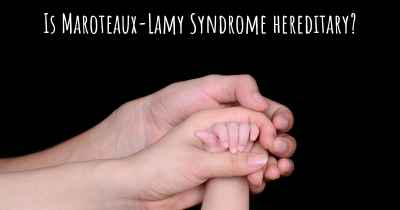What is the history of Maroteaux-Lamy Syndrome?
When was Maroteaux-Lamy Syndrome discovered? What is the story of this discovery? Was it coincidence or not?

Maroteaux-Lamy Syndrome, also known as mucopolysaccharidosis type VI (MPS VI), is a rare genetic disorder that affects the metabolism of certain complex carbohydrates called glycosaminoglycans (GAGs). This condition was first described by French physicians Pierre Maroteaux and Maurice Lamy in 1963.
The discovery of Maroteaux-Lamy Syndrome began with the observation of several patients who exhibited similar symptoms, including skeletal abnormalities, heart and lung problems, and distinctive facial features. Maroteaux and Lamy conducted extensive clinical and laboratory investigations to understand the underlying cause of these symptoms.
After careful analysis, Maroteaux and Lamy identified a deficiency of the enzyme arylsulfatase B (ASB) as the primary cause of the syndrome. This enzyme is responsible for breaking down GAGs in the body. In individuals with Maroteaux-Lamy Syndrome, the lack of functional ASB leads to the accumulation of GAGs in various tissues and organs, causing progressive damage.
Following their initial discovery, Maroteaux and Lamy published their findings in a medical journal, bringing attention to this newly identified disorder. Their work laid the foundation for further research and understanding of Maroteaux-Lamy Syndrome.
Over the years, scientists have made significant progress in elucidating the genetic basis of Maroteaux-Lamy Syndrome. They have identified mutations in the ARSB gene, which provides instructions for producing the ASB enzyme. These mutations disrupt the enzyme's function, leading to the characteristic accumulation of GAGs.
As the understanding of Maroteaux-Lamy Syndrome grew, researchers also developed diagnostic tests to identify affected individuals. These tests involve measuring the activity of ASB enzyme or analyzing the genetic mutations in the ARSB gene. Early diagnosis is crucial for implementing appropriate treatment strategies and managing the symptoms effectively.
Although Maroteaux-Lamy Syndrome is a rare disorder, affecting approximately 1 in 200,000 to 300,000 individuals, it has a significant impact on those affected and their families. The symptoms of the syndrome can vary widely in severity, ranging from mild to severe. Common features include short stature, joint stiffness, heart valve abnormalities, respiratory difficulties, and distinctive facial characteristics such as a broad nose and thick lips.
While there is currently no cure for Maroteaux-Lamy Syndrome, various treatment options are available to manage the symptoms and improve the quality of life for affected individuals. Enzyme replacement therapy (ERT) is a primary treatment approach that involves regular infusions of the missing ASB enzyme. ERT has shown promising results in reducing the accumulation of GAGs and alleviating some of the symptoms.
Additionally, supportive care measures such as physical therapy, respiratory support, and surgical interventions may be necessary to address specific complications associated with the syndrome. Regular monitoring and multidisciplinary care are essential to optimize the management of Maroteaux-Lamy Syndrome.
In conclusion, Maroteaux-Lamy Syndrome, also known as mucopolysaccharidosis type VI, is a rare genetic disorder characterized by the accumulation of glycosaminoglycans due to a deficiency of the arylsulfatase B enzyme. The syndrome was first described by Pierre Maroteaux and Maurice Lamy in 1963, and subsequent research has deepened our understanding of its genetic basis and clinical manifestations. While there is no cure, treatment options such as enzyme replacement therapy and supportive care can help manage the symptoms and improve the quality of life for individuals with Maroteaux-Lamy Syndrome.








